OrbView-2 (formerly SeaStar)
EO
Ocean colour instruments
Ocean
Ocean colour/biology
Quick facts
Overview
| Mission type | EO |
| Agency | NASA, Orbital |
| Mission status | Mission complete |
| Launch date | 01 Aug 1997 |
| End of life date | 11 Dec 2010 |
| Measurement domain | Ocean |
| Measurement category | Ocean colour/biology |
| Measurement detailed | Ocean chlorophyll concentration |
| Instruments | SeaWiFS |
| Instrument type | Ocean colour instruments |
| CEOS EO Handbook | See OrbView-2 (formerly SeaStar) summary |
OrbView-2
OrbView-2 is an imaging satellite, developed, owned, managed and operated by Orbital Imaging Corporation (OrbImage) of Dulles, VA. The overall objective of the OrbView-2/SeaWiFS mission is to provide quantitative data on global ocean bio-optical properties to the Earth science community. The OrbView-2 satellite includes the SeaWiFS (Sea-Viewing Wide Field-of-View Sensor) imaging system, an 8-band multispectral imaging instrument with a one kilometer spatial resolution.
Note: As of Jan. 2006, a commercial imaging company made up of former Orbimage of Dulles VA, and of Space Imaging of Thornton, CO. Orbimage acquired Space Imaging in 2005 and gave the merged company the new name of GeoEye. The new company has HQs in Dulles, VA.
The mission was renamed to "OrbView-2" from "SeaStar" in 1997.
Spacecraft
The spacecraft design is based on PegaStar, a multi-purpose bus of OSC. The platform combines functions common to both satellites and launch vehicles, including guidance and control, power, communications, and data systems. The S/C is three-axis stabilized (0.5º with 0.08º knowledge) using three orthogonal magnetic torque rods for roll and yaw control and two momentum wheels for pitch stabilization. Attitude is sensed with three 2-axis sun sensors, two scanning horizon sensors, and two 2-axis magnetometers. Redundant GPS receivers are used for orbit determination. The propulsion system consists of two subsystems, a reaction control system and a hydrazine propulsion system.
Nominal design life = 5 years. S/C mass = 390 kg. A hydrazine propulsion system using four thrusters is used for orbit raising and orbit maintenance. Four deployed solar panels with zenith-facing cells and two body-mounted side-facing solar panels produce 165 W orbit-average power after 5 years. 1) 2) 3) 4) 5) 6)
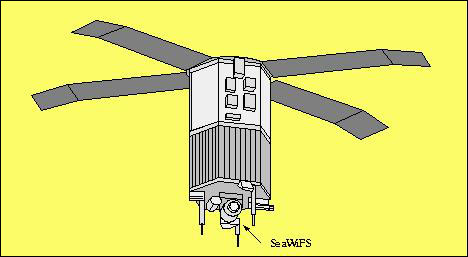
Orbview-2 operations: The OrbView-2 satellite operations (monitoring and control) as well as the commercial data processing and distribution functions are being performed by ORBIMAGE. ORBIMAGE markets the data for commercial and operational use. The processing and distribution of data for research applications is handled by the SeaWiFS Project at NASA/GSFC; the SeaWiFS mission is part of NASA's ESE (Earth Science Enterprise) program.
Application: Ocean-color data, ocean biology and ecology, phytoplankton concentrations and growth, pollution, algae blooms, etc. The data may help scientists to understand the role of ocean plant life in the Earth's carbon cycle.
Orbit: Sun-synchronous polar circular orbit, altitude = 705 km, inclination =98.2º, equator crossing time at local noon (12:00 hours on descending node), successive orbit equatorial crossing longitude = -24.721º, period = 98.2 minutes, orbital repeat time = 16 days (233 orbits).
Launch
The OrbView-2 S/C was air-launched (L-1011 aircraft) on August 1, 1997 by a Pegasus XL rocket (also of OSC) from Vandenberg AFB, CA.
RF communications: On-board storage of sensor data is provided. With two dumps/day, this allows global observations at reduced spatial resolution to be recorded, and a limited amount (about 20 min/day) of high-resolution Local Area Coverage (LAC) data. The real-time LAC data stream is merged with S/C health and instrument telemetry at a rate of 665.4 kbit/s; this is transmitted at L-band with a frequency of 1702.56 MHz.
To increase the coverage of LAC data, NASA encourages the operation of HRPT (High Resolution Picture Transmission) stations by the user community throughout the world. These HRPT stations can collect real time LAC data via direct broadcast whenever the spacecraft is in view. The other telemetry stream consists of stored GAC and selected LAC data, along with S/C health and instrument telemetry, at 2.0 Mbit/s; this is transmitted at S-band with a frequency of 2275.5 MHz. 7)
Satellite transmitting power | 5 Watt |
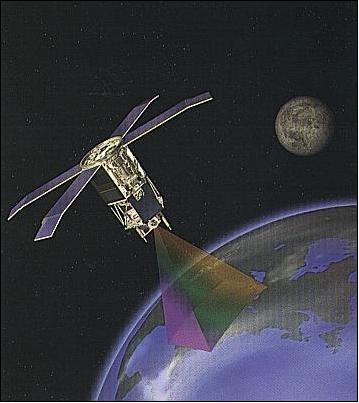
Mission Status
• The OrbView-2 spacecraft, which carried SeaWiFS (Sea-viewing Wide Field-of-view-Sensor), stopped communicating with Earth-based data stations in December 2010. After several months trying to revive the link, flight controllers officially ended the mission in February 2011. The SeaWiFS project of NASA received 13 years of operational data from a spacecraft with a design life of 5 years - a remarkable a long-term record of ocean color data. 8) 9) 10)
- From 1998 to 2010, SeaWiFS made a simple but elegant measurement: how “green” is the Earth. That is, how much chlorophyll—the pigment that helps turn sunlight into organic energy for plants—is present in the seas and on land. Those measurements offered a window into the planet's ability to support life. The long, well-calibrated data record also gives scientists one of the best benchmarks to study the planet’s biological response to a changing environment.
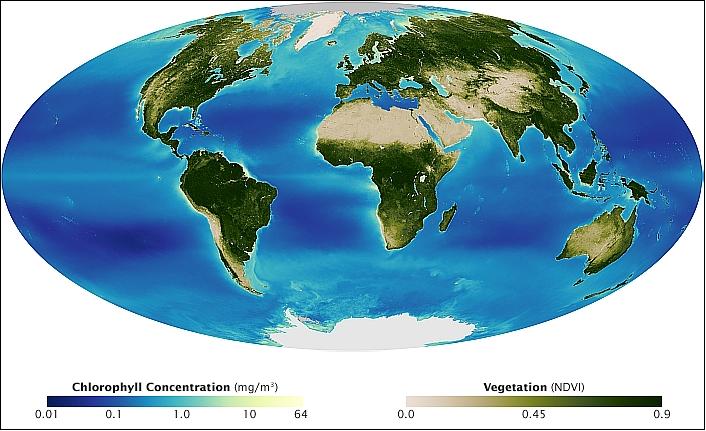
Legend to Figure 3: For the oceans, the colors represent the concentration of chlorophyll and indicate where phytoplankton most often bloomed since 1998. On the land, data are depicted as a Normalized Difference Vegetation Index (NDVI), which shows the density of green vegetation. An NDVI of zero means no green plants and a high value (0.8 or 0.9) is a thick canopy of green leaves.
- SeaWiFS was NASA’s first “data buy” mission, in which a private company (Orbital Sciences) designed and built the instrument and spacecraft to NASA specifications and NASA agreed to purchase the data as long at it met certain scientific requirements. (In later years, GeoEye operated the spacecraft.)
- SeaWiFS was designed to measure ocean color. This seemingly narrow measurement captures the fundamental biological activity at the ocean surface, the blooming and die-off of the phytoplankton that form the center of the oceanic food web. Its abundance is a direct indicator of the seas’ ability to support life. It also plays a central role in the oceans’ carbon uptake. SeaWiFS also was used to offer real-time monitoring of red tides and other harmful algae, which can bloom in polluted waters and be deadly to fish and oysters.
- Modifications made to SeaWiFS before launch also allowed it to make a similar kind of measurement of plant color on land. This ability to see all of the planet’s plant life with a single, well-calibrated instrument produced a first-of-its-kind snapshot of the Earth’s biosphere in 1998, similar to the image of Figure 3 (Ref. 8).
- In addition to its support of commercial services and GeoEye, SeaWiFS was nicknamed “The Little Satellite That Could” for the quantity and quality of science it produced. SeaWiFS data has appeared in nearly 5,000 publications. It has been a model for partnership of a NASA science mission with commercial operator and imagery provider.
• The SeaWiFS sensor of OrbView-2 has been offline since December 14, 2010. 11)
• The OrbView-2 mission is operational in 2010 (in its 13th year on orbit). The sensor is operating normally with no apparent degradation in performance; radiometric stability has been maintained with the lunar calibration. The OrbView-2 spacecraft has experienced failures or anomalies on multiple primary systems/components and is operating on the backup units: 12)
- Spacecraft computer
- GPS receiver
- SeaWiFS interface unit
- Battery charge regulator.
Although there have been gaps in data collection during the past two years, there are no indications of imminent mission-ending failure. The spacecraft orbit has not been maintained, and the equator crossing time has drifted from local noon to about 14:00 hours.
• In March 2008, NASA exercised its option for another year of global SeaWiFS data (GAC) starting on April 12, 2008. 13)
• In January 2008, the OrbView-2 spacecraft experienced a telemetry anomaly (no availability of GPS attitude data). However, the spacecraft returned to a save condition - and service provision was reestablished in early April 2008.
• In August 2007, the OrbView-2 spacecraft and its payload were operational completing their 10th year on orbit. SeaWiFS data comprise the longest continuous record of global ocean information including biology and biogeochemical properties.
• In 2006, OrbView-2 continued to perform exceedingly well on orbit, exceeding its design life by far. On May 16, 2006, NOAA and NASA had come to an agreement with GeoEye (formerly ORBIMAGE) to continue to provide further coverage of SeaWiFS data to the worldwide data user community.
• August 2004 represented the 7th anniversary of satellite operations and data services at ORBIMAGE. Over the past seven years, SeaWiFS has provided an uninterrupted stream of global, internally consistent, climate-quality, ocean-color data, with an unprecedented availability rate of over 98%. SeaWiFS is regarded as the benchmark against which all ocean-color missions are compared.
At the end of 2004, ORBIMAGE expected OrbView-2 to continue providing service for at least another 3 to 5 years. However, NASA's contract with ORBIMAGE for data provision for the research community ended on Dec. 23, 2004. ORBIMAGE was not willing to extend the research service contract which meant that the research community (over 2000 NASA program researchers) had to negotiate directly with ORBIMAGE for service continuation. 14)
• In Dec. 2002, NASA extended the original 5-year contract with OrbImage for continued service provision (two year extension).
Sensor Complement
SeaWiFS (Sea-Viewing Wide Field-of-View Sensor)
SeaWiFS was built by Raytheon SBRC of Goleta, CA. Objective: measurement of reflected visible sunlight from the ocean surface for the derivation of ocean-color data. The SeaWiFS sensor may be regarded as a next generation instrument of CZCS (Nimbus-7 sensor which ceased operations in 1986, after an eight-year mission). The SeaWiFS instrument employs scanning mechanisms to drive an off-axis (afocal) folded-optics scanning telescope and a rotating half-angle mirror that is phase-synchronized with, and rotating at half the speed of, the folded telescope. The scanning telescope design minimizes the polarization sensitivity and, correspondingly, maximizes the radiometric fidelity of its ocean color measurements.
The SeaWiFS scanning concept employs a 360º uni-directional cross-track rotating telescope scanner. A small counter-rotating flat scan mirror between the telescope and the focal planes eliminates image rotation which would otherwise occur as the telescope rotates. The absence of FOV rotation permits the use of a multichannel, time delay integration (TDI) processing in each of the eight spectral bands to achieve the required SNR. Incoming scene radiation is collected by the folded telescope and reflected onto the rotating half-angle mirror. The collected radiation is then relayed through dichroic beam splitters to separate the radiation into four wavelength intervals (each wavelength encompassing two of the eight SeaWiFS spectral bands). The radiation in the four separate wavelength intervals is directed by four corresponding aft-optics assemblies through two separate spectral bandpass filters that further separate the radiation into the eight required SeaWiFS spectral bands. The aft-optics also image each of the resultant bands of radiation onto four silicon detectors that are aligned in the scan direction. The detected signals are then amplified for TDI processing in the electronics module. 15) 16)
Nr. of imaging bands | 8 |
Spectral ranges (nm) | 402-422, 433-453, 480-500, 500-520, 545-565, 660-680, 745-785, 845-885 |
Spatial resolution | 1 km |
Swath width | 2800 km (continuous imaging) |
Radiometric accuracy | < 5% absolute each band |
Calibration/stability monitor | solar diffuser, lunar view |
Relative precision | < 1% linearity of signal output to radiance |
Between-band precision | < 5% relative band/band over 50 - 90% of saturation |
Polarization sensitivity | < 2% worst case, all scan and tilt angles |
Dynamic range | 15,000:1 using bilinear gain |
Bright target recovery | < 10 samples |
Location knowledge | 0.5 km, at 1-sigma level for instrument |
Revisit time | 1 day |
Maximum data rate | 2 Mbit/s |
Instrument mass, design life | 45 kg, 5 years |
The off-axis telescope (with an aperture of 7.6 cm; f/2) rotates at six revolutions per second (or 360 rpm) in the cross-track direction (for HRPT format compatibility) to provide contiguous scan coverage. Data quantization = 10 bit; spatial resolution = 1.6 mrad (1.13 km at nadir); an active scan angle of ±58.3º is used. A scanner tilt mechanism enables the entire sensor to be oriented in the along-track direction to +20º, 0º, or -20º to avoid specular sun reflection (sun glint from the sea surface).
Band | Wavelength | Measurement Parameter | Saturation Radiance | Input Radiance | SNR (Measured at Input Radiance) |
1 | 402 - 422 | Gelbstoffe | 13.63 | 9.10 | 499 |
Instrument calibration: SeaWiFS uses short-period solar calibration (for a few orbits) and long-term lunar calibration (for a few months and longer). Solar calibration employs a solar radiation diffuser and an input port located in a fixed position outside of the 58.3º SeaWIFS scene-scan interval. Lunar calibration is accomplished by a S/C maneuver to view the moon during the nighttime portion of an orbit. Of particular importance to the postlaunch validation period are field measurements from MOBY (Marine Optical Buoy, located off the coast of Lanai, Hawaii. 17) 18) 19) 20)
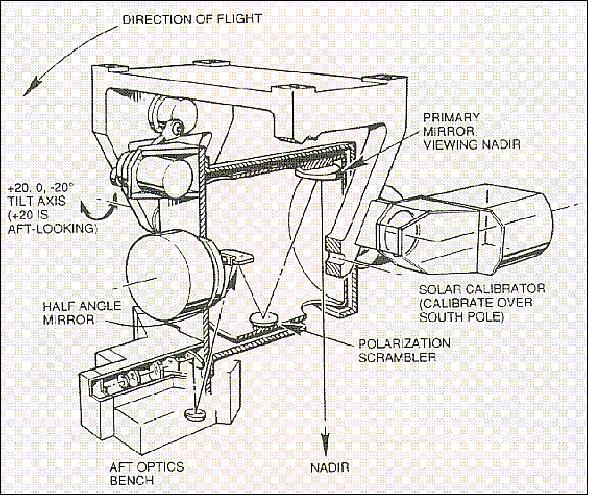
To protect the commercial interests of the builder and operator of the mission, ORBIMAGE, SeaWiFS real time LAC data are encrypted. All data users require a license from OSC (a decryptor is furnished with the license). Commercial data users pay a fee for their license, research licences are issued at no cost, but are subject to certain restrictions. Commercial stations requesting HRPT stations for research data use must obtain prior approval from NASA (SeaWiFS Project Office at GSFC).
Sensor Parameter | GAC Mode | LAC Mode | |
Scan width (degree) | 45º | 58.3º | |
IFOV at sensor (mrad) | 1.5835 | 1.5835 | |
Ground IFOV at nadir (km) - spatial resolution | 4.5 | 1.13 | |
Ground swath width, km | 1500 | 2800 | |
Pixels along-scan | 248 | 1285 | |
Pixel numbers | (147 - 1135, by 4) | (1-1285) | |
Scans/second | 1.5 | 6 | |
Scan plane tilt | 20º | 20º | |
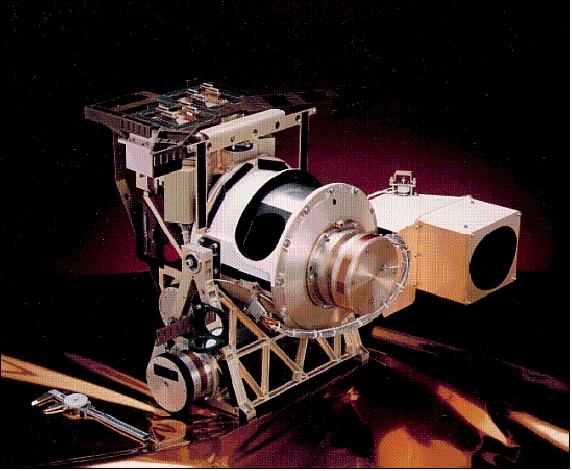
References
1) “Orbital Sciences Captures $120 Million in Business, Pegasus Launches Ocean Satellite Ordered,“ Space News, March 11-17, 1991, p. 7
2) “OSC Reviews Seastar Design,” Space News, Oct. 28 - Nov. 3, 1991, p. 22
3) P. R. Leygraaf, “OrbView-2 (SeaStar) Flight Operations and Data Delivery,” Proceedings of the 11th AIAA/USU Conference on Small Satellites, Sept. 15-18, 1997, Logan, UT
4) http://oceancolor.gsfc.nasa.gov/SeaWiFS/BACKGROUND/
5) SeaWiFS Project Home Page at http://seawifs.gsfc.nasa.gov/SEAWIFS.html
6) http://eospso.gsfc.nasa.gov/eos_homepage/mission_profiles/docs/Orbview-2_SeaWiFS.pdf
7) “Roles and Responsibilities of HRPT Stations for SeaWiFS,” SeaWiFS Project Office, GSFC, Dec. 19, 1991
8) Lorraine Remer, Gene, Carl Feldman, Paul Przyborski, “Thirteen Years of Greening from SeaWiFS,” NASA, April 4, 2011, URL: http://earthobservatory.nasa.gov/IOTD/view.php?id=49949&src=eoa-iotd
9) Patrick Lynch, “The End of a Remarkable Mission: SeaWiFS’ Thirteen Years of Observing our Home Planet,” NASA, April 4, 2011, URL: http://www.nasa.gov/topics/earth/features/seawifs_end.html
10) http://www.fluidr.com/photos/gsfc/sets/72157626083151820
11) “SeaWiFS Status: Gene Carl Feldman,” Ocean Color Forum, Jan. 24, 2011, URL: http://oceancolor.gsfc.nasa.gov/forum/oceancolor/topic_show.pl?tid=3858#fp
12) Fred Patt, “SeaWiFS Status,” NASA, Feb. 5, 2010, URL: http://modis.gsfc.nasa.gov/sci_team/meetings/201001/presentations/ocean/patt1.pdf
13) http://oceancolor.gsfc.nasa.gov/forum/oceancolor/topic_show.pl?tid=2334
14) http://www.ioccg.org/news/Dec2004/news.html
15) “System Concept for Wide-Field-Of View Observations of Ocean Phenomena from Space,” NASA-NOAA-Eosat publication, 1987
16) H. v.d. Piepen, V. Amman, R. Doerffer, “Remote Sensing of Substances in Water,” GeoJournal 24.1, pp. 24-27, 1991 (May) by Kluwer Academic Publishers
17) G. Valenti, “Sea-viewing Wide Field-of-view Sensor,” The Earth Observer, March/April 1998, Vol 10, pp. 20-22
18) Note: the reflected radiance is related to the concentration of chlorophyll and other plant pigments present, since chlorophyll is a green pigment and the color of the water changes from blue to green as the concentration of chlorophyll increases. If the concentration of chlorophyll is known, the amount of phytoplankton, or `ocean color,' may be calculated.
19) “An Overview of SeaWiFS and the SeaStar Spacecraft,” URL: http://oceancolor.gsfc.nasa.gov/SeaWiFS/SEASTAR/SPACECRAFT.html
20) Charles R. McClain, Gene C. Feldman, Stanford B. Hooker, “An overview of the SeaWiFS project andstrategies for producing a climate research quality global ocean bio-optical time series,” Deep Sea Research II, Vol. 51, 2004, pp. 5-42, URL: http://www.optics.marine.usf.edu/references/McClain_DSR2004.pdf
The information compiled and edited in this article was provided by Herbert J. Kramer from his documentation of: ”Observation of the Earth and Its Environment: Survey of Missions and Sensors” (Springer Verlag) as well as many other sources after the publication of the 4th edition in 2002. - Comments and corrections to this article are always welcome for further updates (eoportal@symbios.space).